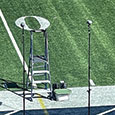In the mid-1990s, I invited Michel Debost to be the guest artist at my Pocatello Flute Week. While I had not met him personally, I was a fan of his column in Flute Talk and wanted to share his wealth of information and knowledge with my students. When Debost accepted the invitation, he suggested we play a duo recital on the opening night of the festival. One of the pieces he wanted to perform was the Faure Fantasie, Op. 79 in the two flutes and piano version. I had not realized that there was a duet version of the Faure, but a few days later a second flute part appeared in the mail. The second part had been written by Louis Moyse and had not been published at the time.
As one who has a tendency to over-prepare for concerts, I immediately began to learn the second flute part. Since the first part was identical to the flute part in the original flute and piano version, I decided to play the second part with several students who already knew the work. This produced good results but only showed me how the two parts lined up compositionally. I wanted my second flute part to complement Debost’s interpretation so I decided to practice my part by playing along with his CD. This practice technique proved to be an excellent idea because at our first rehearsal, we played as if we had already performed many concerts together. I knew how he would shape phrases, use coloring techniques, and take time.
When I was a young student at Eastman, American flutists learned only a few of the French Conservatoire concours selections. I am not sure why this was the case, but mostly we learned the Chaminade Concertino, Enesco Cantabile et Presto, and Faure Fantasie. During a practice session with Debost’s CD, I happened to look over the other repertoire on the CD and noted he had recorded many of the prominent French concours solos. By this time in my practice, I was in awe of Debost’s performance of the Faure both technically and artistically so I spent some time listening to his performances of these other works. I decided to learn all these compositions, and my goal was to get to the point where I could play with the entire CD imitating his mannerisms and nuances.
This project was one of the best I have done as a flutist. First I listened with the full score and then made a plan for learning these new works. A few weeks later I was ready for my first run-through with Debost’s CD. It went better than I expected. When I started this project I only wanted to learn this French repertoire, but as I continued to play these pieces day after day, all in a row with the CD, I realized I was not only learning the music but was also getting an insight into the French style of flute playing – and, I was learning it from a master.
As the weeks progressed, I became passionate about this music, and the French approach to performing it. I quickly realized that once the music was learned, I could play all the selections in slightly over an hour. Some days I played with the CD; other times I played alone or with a metronome. This period of time proved to be one of intense growth both musically and flute-wise.
Many purists would argue that I was copying Debost’s interpretations, and I will be the first to admit that I was. However, Bach learned to compose by hand-copying works by Vivaldi, and Beethoven broke into his brother’s music cabinet to look at scores to broaden his compositional horizons. Before you can become original, you have to understand what has come before and how to imitate it.
I was not alone in my imitation. When I was a student of Julius Baker, he told me of his admiration for the playing of Joseph Mariano. He commented that when he bought Mariano’s recording of the Griffes Poem the first thing he did was copy it onto a reel-to-reel tape recorder. Then rather playing the recording in the traditional manner he hand-fed the tape through the machine listening to Mariano’s performance note-by-note, observing where he changed colors, what notes he grouped together, and how many vibrato cycles he put on each note in an effort to get inside of Mariano’s creative mind. My project was similar to Baker’s only I used a CD recording rather than a 33rpm and tape recorder.
While most performers will not admit to playing along with a CD, I think most have done it sometime during their studies. One day while I was waiting for my son to have his horn lesson, I noted that his teacher had CDs strewn across the dining room table. On closer look I realized that they all were chamber music works with a horn part. I asked what he was doing, and he said, “I play along with the CDs. This way I get to perform with a much higher caliber musician than I usually do.”
Later that summer after the flute week and Debost’s visit, I thought about other one-hour projects that I might undertake in the future. I remembered Mariano saying once that he could play the Berbiguier 18 Exercises and several of the Andersen etude books each in a little less than an hour. I decided to give it a try and realized that I could do this too. While Mariano never mentioned to me how busy he was and how little personal practice time he had, I know from my own experience that professional flutists and teachers have very little personal time. Figuring out how to make the most out of that small time is the key to success. While maintenance practice is necessary, figuring out a practice strategy where you also grow musically is an important objective.
My next project was the Bach Six Sonatas (b, Eb, A, C, e, E). I had heard Jean-Pierre Rampal play a concert on the radio from Stanford in which he played all the sonatas on one concert. I decided I wanted to be able to do that too whether I actually gave the concert or not. Rampal played in large cities and for sophisticated audiences on college campuses, so his listeners were ready and eager for a concert of all Bach. In Idaho where I lived at the time, I knew this would be a poor programming choice. Still I liked the idea of preparing all these works. At one time or another, I had already performed each Bach Sonata on a separate program, so now my challenge was to develop the endurance and concentration to play them all in a row. This project takes approximately 70 minutes start to finish.
Through the years I have continued on my journey to find groupings of compositions to play daily in about an hour. The Twelve Fantasias by George Philip Telemann come in just under an hour as do the 30 Caprices by Karg-Elert and the two Mozart Concertos. I cannot exactly articulate what happens in your playing and musicianship when you play these works repeatedly for a period of time and with a CD. I think the benefit is derived by developing the concentration to perform accurately for a period of time plus learning to imitate another’s voice. After a while I abandoned the CDs and played alone and began to find my own way. All and all it was an immensely rewarding process.
As a university professor, I adapted this project for each flutist’s senior recital preparation. First we selected a program based on graduation requirements of the university. Then I helped students plan an overall preparation strategy. At the point when the music was learned and could be played in the correct tempo, I asked which recordings were listened to over the course of learning the music. With my help we selected the strongest recorded interpretations and made a play list for an ipod or computer.
Generally each composition on the program was selected from a different artist. One artist might specialize in Baroque performance practice, while another could be a Romantic music specialist. Once the listening tracks were compiled, each flutist was to play the recital once a day with the recorded media. This was usually done for about a month before the recital.
Each year I usually had between three and five graduation recitals spread throughout the spring semester. While some students were skeptical of this process of daily playing with a pre-recorded CD, the first person who gave a recital always endorsed the benefits of this practice technique and sold the idea to the others.
The process works because students began to look at the program as a whole, not just as one piece after another. They soon discovered it was necessary to switch styles and character from one composition to the next. One of the best benefits was that they practiced concentrating for about an hour over thirty times before walking on stage for the recital. Since most seniors are still in a development stage for phrasing and pacing, playing with some of the best flutists in the world placed the bar higher than if they had played alone for this period of time. I also think each student’s control of intonation improved because while playing with the flutists on the CD, they also played with the pianist and learned to tune from the bass notes up.
For younger students who do not have an hour’s worth of repertoire, select one recital selection and have them play it once through with a recording for thirty days. This practice technique will certainly take them to the next performance level both musically and technically. While recorded accompaniment programs are good, I think playing along with another flutist offers many additional benefits.






